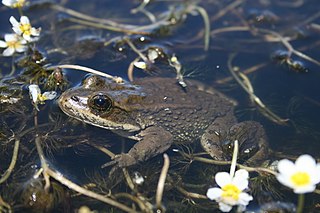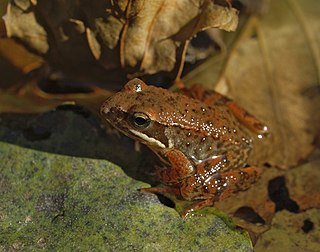Related Research Articles

Mo i Rana is a city, and the administrative centre of the municipality of Rana, in Nordland county, Norway. It is located in the Helgeland region of Nordland, just south of the Arctic Circle. Some of the city's suburbs include Båsmoen and Ytteren in the north, Selfors in the east, and Åga/Hauknes/Dalsgrenda in the south.

Tribhuwan Bir Bikram Shah was King of Nepal from 11 December 1911 until his death. Born in Kathmandu, the capital city of Nepal, he ascended to the throne at the age of five, upon the death of his father, Prithvi Bir Bikram Shah, and was crowned on 20 February 1913 at the Nasal Chowk, Hanuman Dhoka Palace in Kathmandu, with his mother acting as regent. At the time of his crowning, the position of monarch was largely ceremonial, with the real governing power residing with the Rana family.

The common frog, also known as the European common frog, European common brown frog, European grass frog, European Holarctic true frog, European pond frog or European brown frog, is a semi-aquatic amphibian of the family Ranidae, found throughout much of Europe as far north as Scandinavia and as far east as the Urals, except for most of Iberia, Southern Italy, and the southern Balkans. The farthest west it can be found is Ireland. It is also found in Asia, and eastward to Japan.

Pratap Singh I, popularly known as Maharana Pratap, was a Hindu Rajput king of Mewar. He was titled as "Mewari Rana" and was notable for his military resistance against the expansionism of the Mughal Empire and is known for his participation in the Battle of Haldighati and the Battle of Dewair.

Rana is a genus of frogs commonly known as the Holarctic true frogs, pond frogs or brown frogs. Members of this genus are found through much of Eurasia and western North America. Many other genera were formerly included here. These true frogs are usually largish species characterized by their slim waists and wrinkled skin; many have thin ridges running along their backs, but they generally lack "warts" as in typical toads. They are excellent jumpers due to their long, slender legs. The typical webbing found on their hind feet allows for easy movement through water. Coloration is mostly greens and browns above, with darker and yellowish spots.

The prime minister of Nepal is the head of government of Nepal. The prime minister is the head of the Council of Ministers of Nepal and the chief adviser to the President of Nepal. The prime minister is a member of the House of Representatives and is the highest ranking federal officer within the government.

The foothill yellow-legged frog is a small-sized 3.72–8.2 cm (1.46–3.23 in) frog from the genus Rana in the family Ranidae. This species can be found in the Coast Ranges from northern Oregon, through California, and into Baja California, Mexico as well as in the foothills of the Sierra Nevada and southern Cascade Range in California. The foothill yellow-legged frog is a Federal Species of Concern and California State Endangered.

Rana dynasty is a Chhetri dynasty that imposed totalitarianism in the Kingdom of Nepal from 1846 until 1951, reducing the Shah monarch to a figurehead and making Prime Minister and other government positions held by the Ranas hereditary. They claimed Kshatriya status themselves. Rana dynasty is historically known for the iron-fisted rule. This changed after the Revolution of 1951 with the promulgation of a new constitution, when power shifted back to the monarchy of King Tribhuvan.

The Columbia spotted frog is a North American species of frog. It is green to brown in color with spots on the dorsal surface. The belly and upper lip are white in color. Individuals can be distinguished from other Rana species by their shorter back legs, narrow snout, and upturned eyes. Since they spend most of their time in the water, they also have more webbing in their hind feet than similar species. Although not threatened, this animal has been studied as a model species for the effects of habitat fragmentation.

The Battle of Haldighati was a battle fought on 18 June 1576 between cavalry and archers supporting the Rana of Mewar, Maharana Pratap, and the Mughal emperor Akbar's forces, led by Man Singh I of Amber. The Mughals were the victors and inflicted significant casualties among the Mewaris but failed to capture Pratap, who escaped.

Rana amurensis is a species of true frog found in northern Asia. It ranges across western Siberia, as well as northeastern China, northeastern Mongolia, and on the northern Korean Peninsula and on Sakhalin. Rana coreana was previously included in this species as a subspecies. Found at latitudes up to 71° N, it is the northernmost wild amphibian species.

The Iberian frog, also known as Iberian stream frog, is a species of frog in the family Ranidae found in Portugal and Spain. Its natural habitats are rivers, mountain streams and swamps. It is threatened by habitat loss, introduced species, climate change, water contamination, and increased ultraviolet radiation.

Rana longicrus, also known as the Taipa frog or long-legged brown frog, is a species of frog in the family Ranidae. It is distributed to northern and central Taiwan.

Ramanaidu "Rana" Daggubati is an Indian actor and producer known primarily for his work in Telugu language films, in addition to Hindi and Tamil languages.
Eupromerini is a tribe of longhorn beetles of the subfamily Lamiinae.
Iquiracetima is a genus of longhorn beetles of the subfamily Lamiinae, containing the following species:
Iquiracetima aspasia is a species of beetle in the family Cerambycidae. It was described by Galileo and Martins in 1995. It is known from Ecuador and Peru.
Iquiracetima brachialis is a species of beetle in the family Cerambycidae. It was described by Thomson in 1868. It is known from Brazil.
Iquiracetima cerari is a species of beetle in the family Cerambycidae. It was described by Galileo and Martins in 2008. It is known from Brazil.
Iquiracetima tuberosa is a species of beetle in the family Cerambycidae. It was described by Belon in 1896. It is known from Ecuador, Bolivia, and Brazil.
References
- ↑ BioLib.cz - Iquiracetima rana. Retrieved on 8 September 2014.